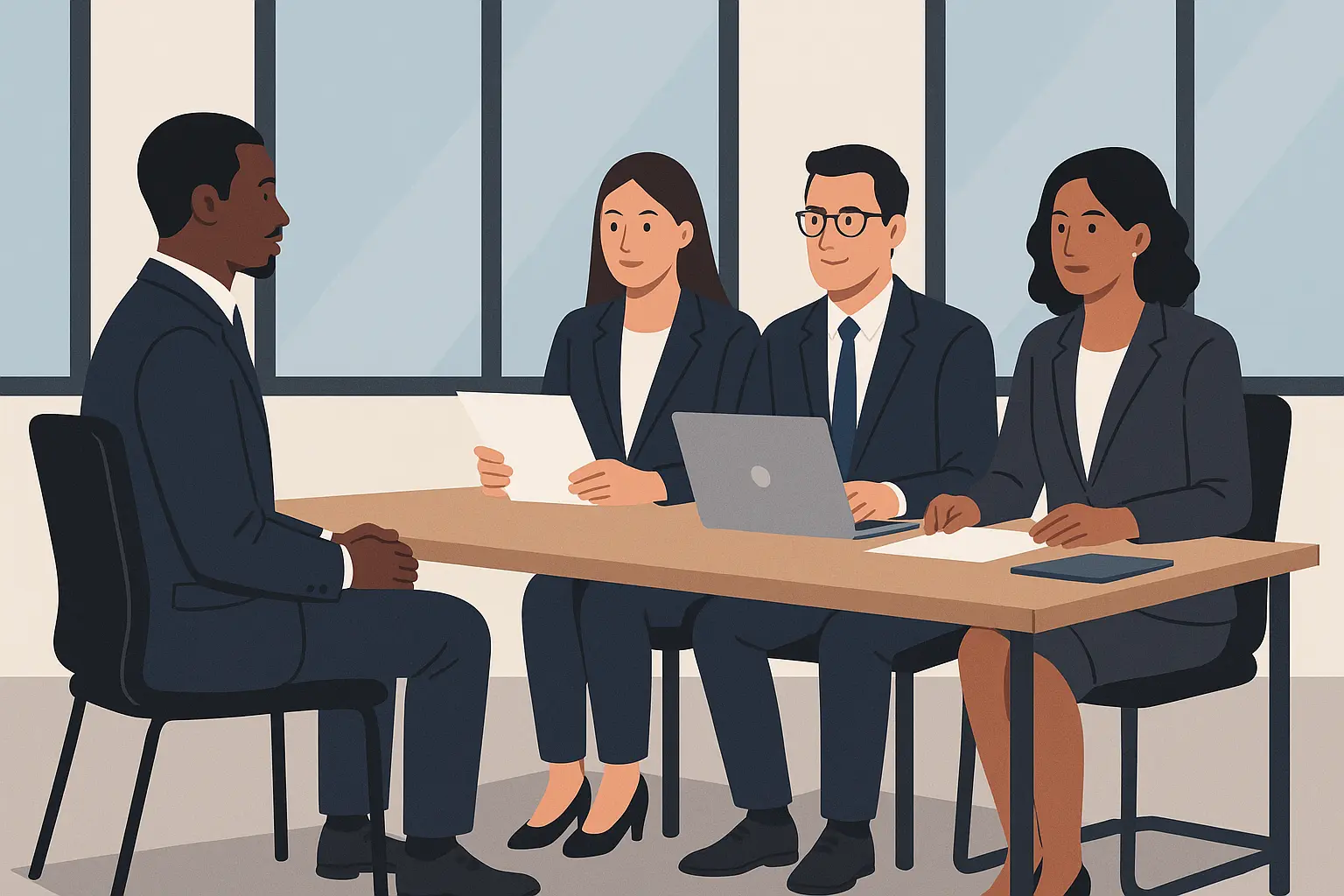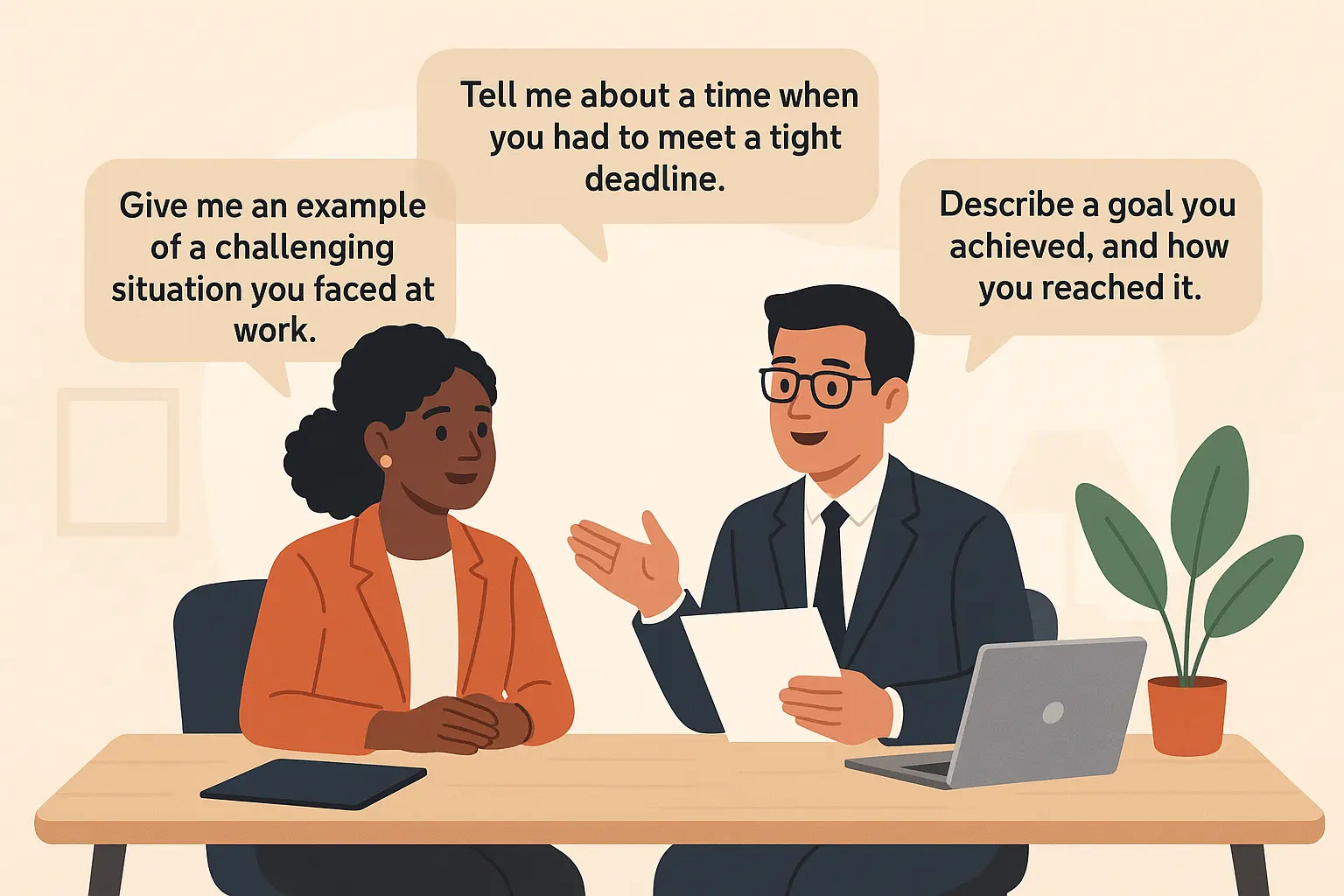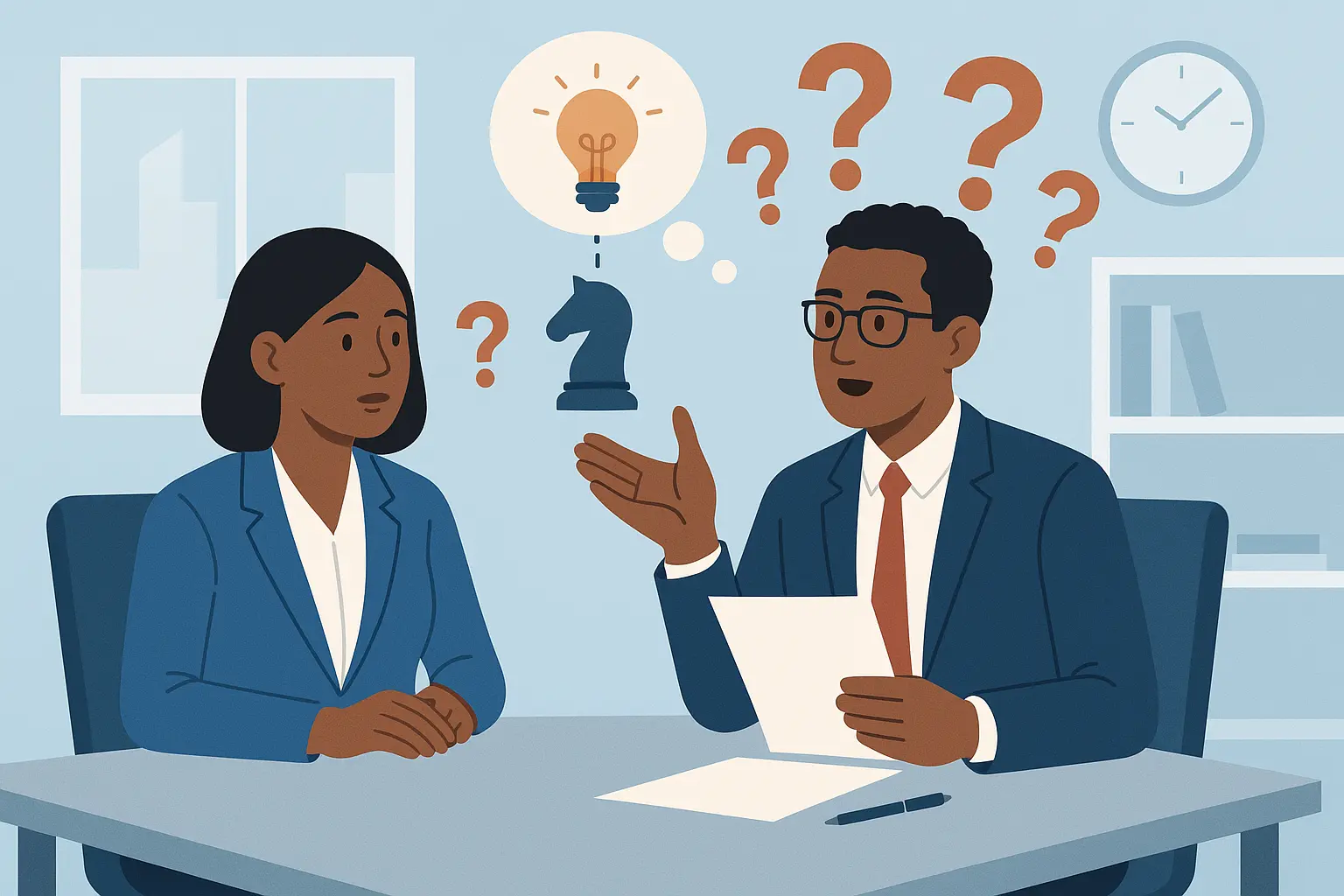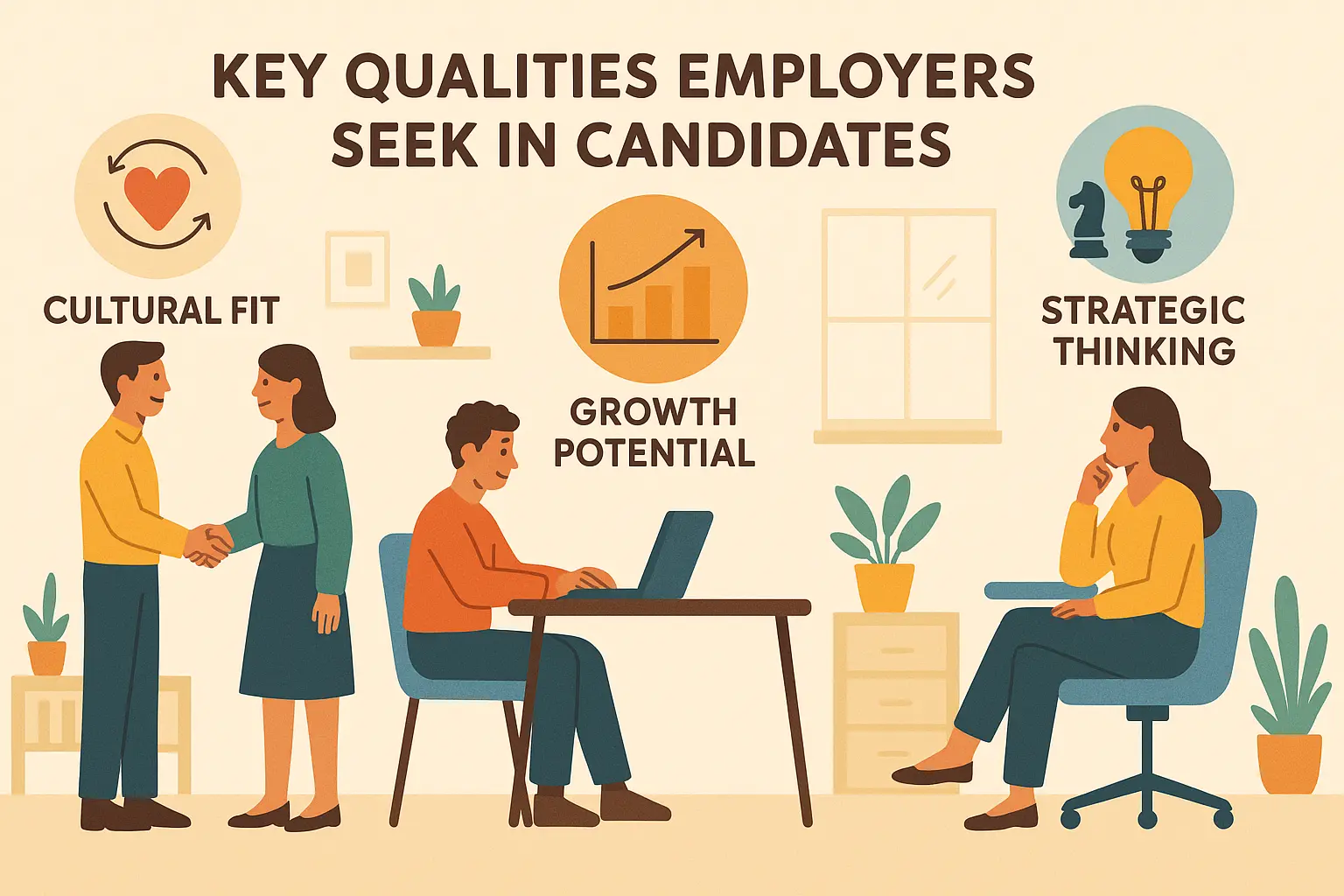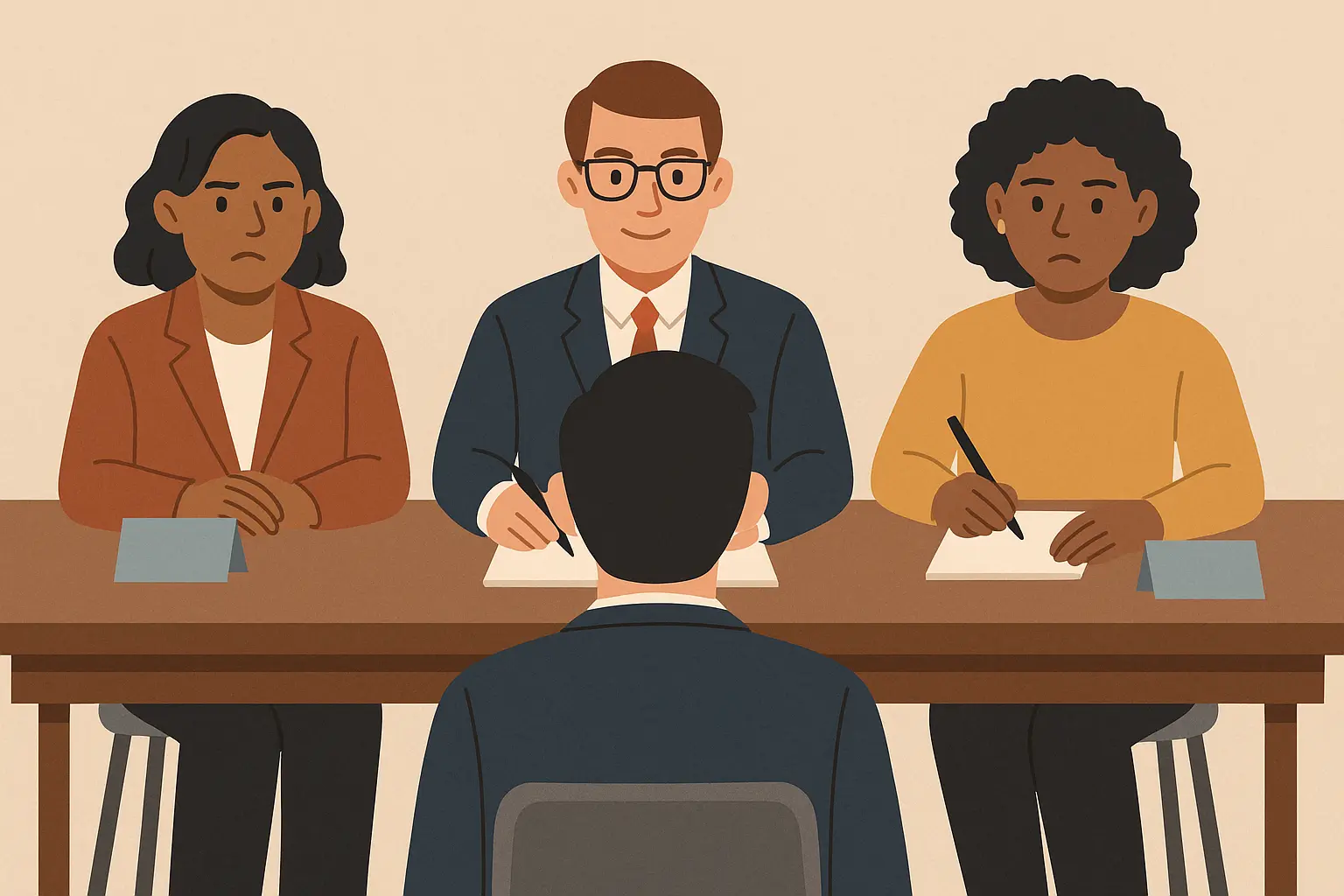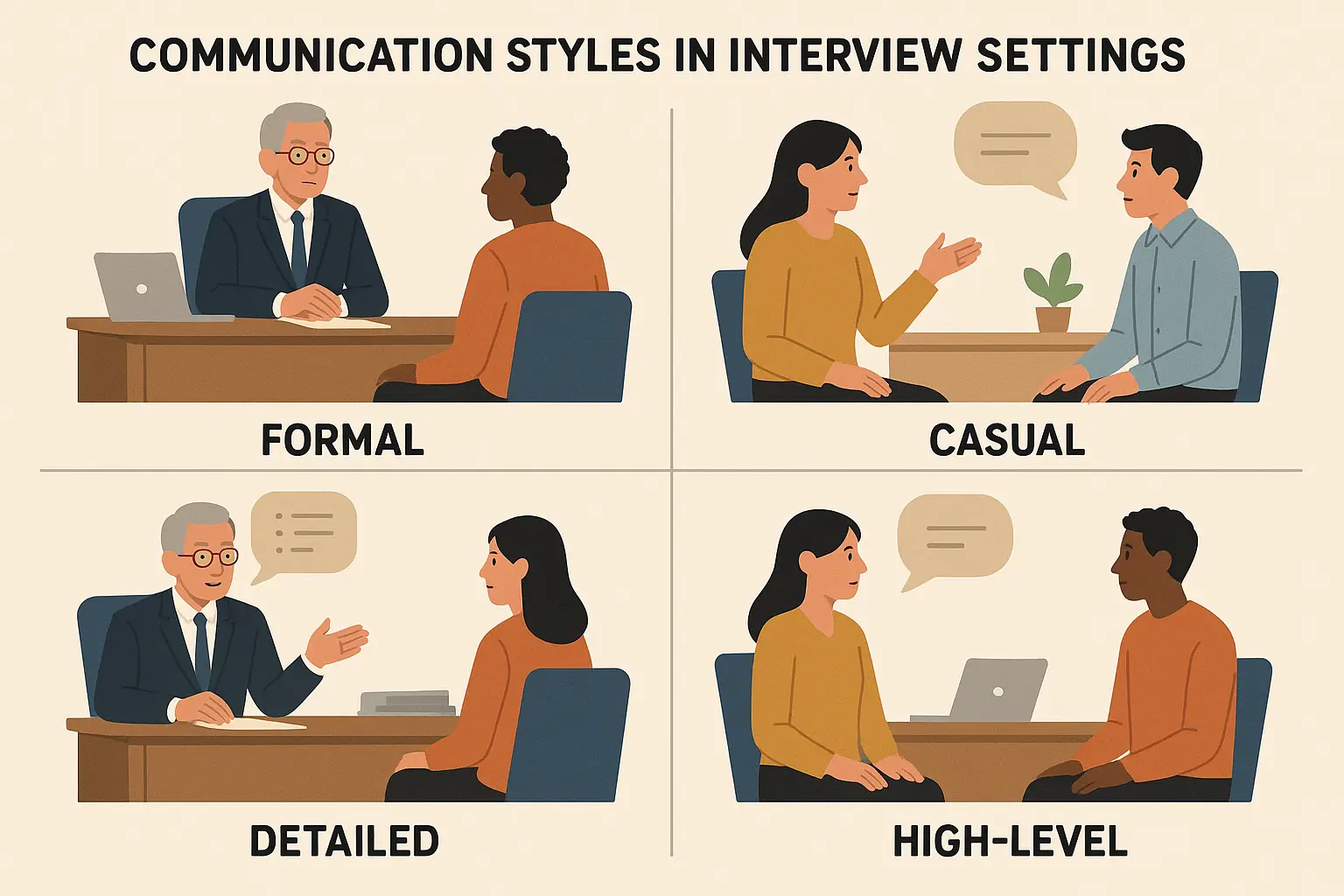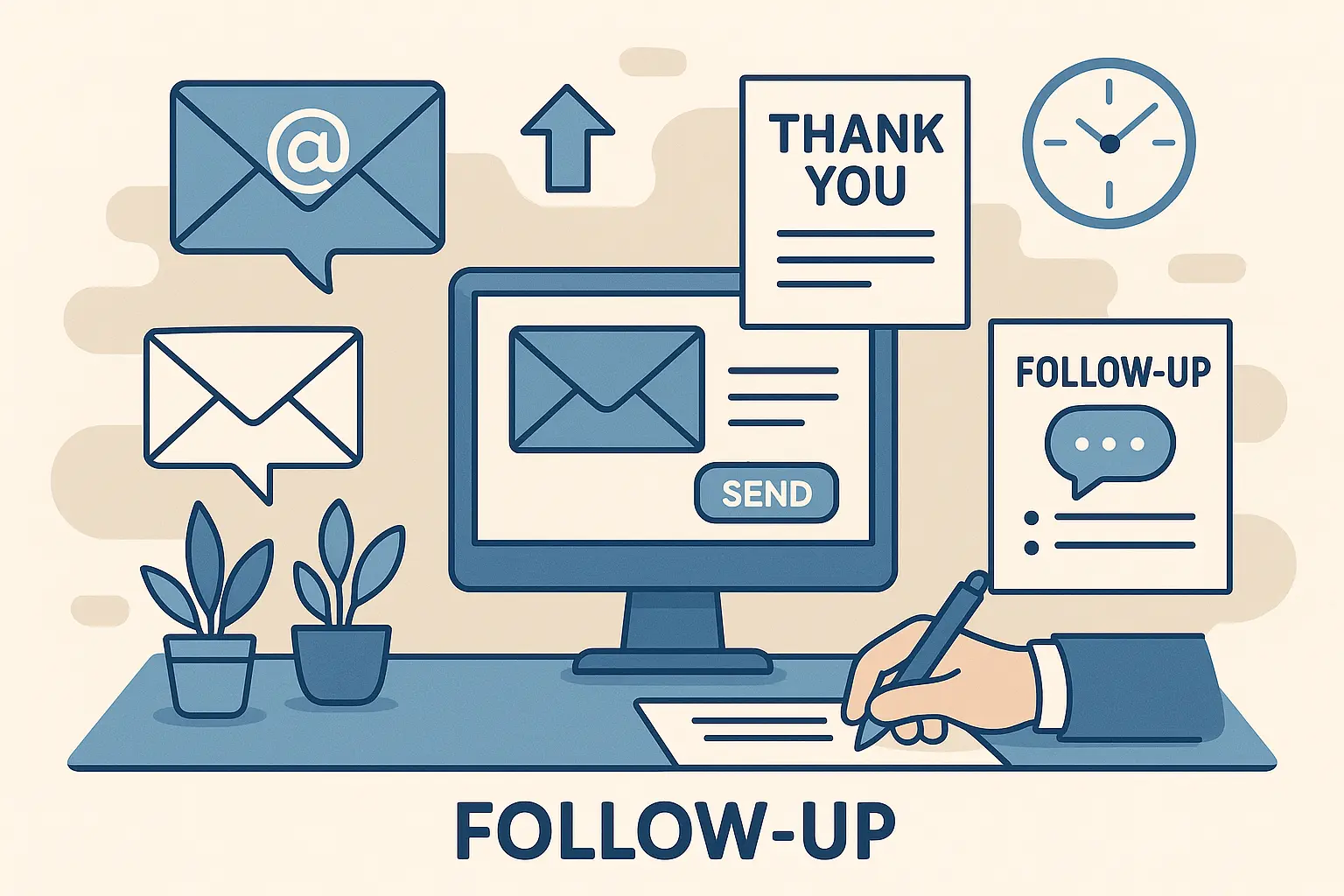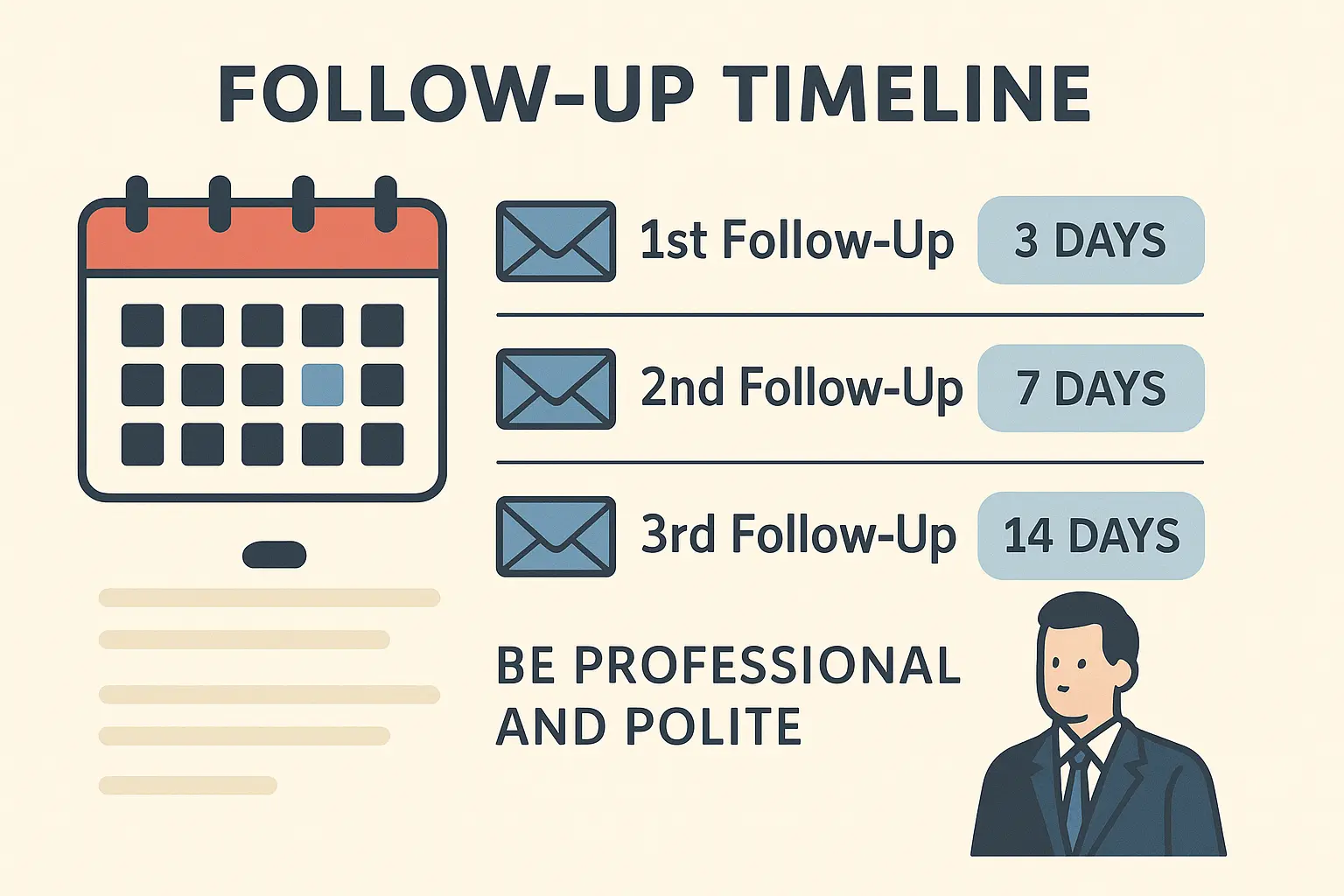Second Interview Questions That Actually Matter: What Hiring Managers Really Want to Know

Congrats – you made it to round two! Only about 20% of candidates get this far according to The Interview Guys, which means you’ve already beaten out most of the competition. But here’s the thing: now it gets real. The first interview was about checking boxes. This one? They want to know if they actually want to work with you every day. That’s why preparing for common second interview questions is the smartest move you can make.
Table of Contents
- Understanding What Makes Second Interviews Different
- The Real Questions You’ll Face (And Why They Ask Them)
- Smart Questions That Show You’re Serious About the Role
- What Employers Are Actually Looking For
- Managing Multiple Interviewers Without Losing Your Mind
- How to Follow Up Like a Pro
TL;DR
- Round two digs way deeper – they’re checking if you’ll fit in, stick around, and maybe even lead someday
- Get ready for tons of “tell me about a time when…” questions – have 8-10 solid stories ready
- Your questions matter just as much as your answers – ask about real challenges, not generic stuff
- You’ll probably meet multiple people with different priorities – stay consistent but adapt your approach
- Follow up matters, but don’t overthink it – reference something specific from your conversation and keep it real
Understanding What Makes Second Interviews Different
You know that feeling when you walk into round two and the whole energy has shifted? That’s because everything changes after the first interview. They already know you can do the job – now they want to know if they actually want to work with you when things get messy. Expect second interview questions that dig into your personality, leadership, and how you think under pressure.
I’ve been through my share of these, and trust me, the difference is night and day. The questions get personal. The stakes feel higher. Suddenly you’re not just proving you can handle the technical stuff – you’re showing them who you are when the pressure’s on.
Why Everything Changes After Round One
The transition isn’t just about meeting more people – it’s a complete shift in what they’re trying to figure out. First interviews are pretty predictable: “Tell me about yourself,” “Why this role,” maybe a few technical questions to make sure your resume isn’t complete fiction.
But second interviews? They throw you curveballs that don’t have obvious answers. Real-world programs are catching onto this too. The U.S. Army recently ran “mock interviews” for high school students at Aberdeen Proving Ground, with nearly 50 students practicing with professional panels. As one student put it: “I got a job over the summer, using the interview skills I learned here.” That’s the power of proper preparation.
From Skill Checking to Deep Diving
Think of it this way: first interviews are like speed dating. Second interviews are like meeting the parents. They want to see what’s really underneath – how you think, how you make decisions, how you handle situations that don’t have a clear playbook.
You’ve probably noticed first interviews follow a script. But second rounds explore your thought process, decision-making patterns, and how you handle complex situations. Just like crafting an effective resume summary requires distilling your professional essence, these interviews demand that you articulate your value with real depth.
Meeting the People Who Actually Matter
Here’s where it gets interesting – you’ll probably meet your potential boss, future teammates, maybe even senior leadership who want to size you up personally. Each person has different priorities, which means you’re essentially having multiple mini-interviews disguised as one conversation.
Your potential manager cares about whether you can handle day-to-day responsibilities without constant hand-holding. Team members want to know if you’ll pull your weight and not create drama. Senior leadership? They’re thinking bigger picture – whether you have potential to grow and take on more down the road.
Cultural Fit Becomes Everything
Companies have learned the hard way that hiring someone who’s technically solid but culturally misaligned creates problems that ripple through entire teams. This isn’t about liking the same coffee or sports teams – it’s about work style, communication preferences, how you handle stress, and whether your values align with how they actually operate (not just what’s on their website).
The Question Categories That Define Second Rounds
Here are the main categories of second interview questions you’ll most likely face and what they’re designed to reveal:
| Question Type | What They’re Really After | Example |
|---|---|---|
| Behavioral Stories | How you actually operate under pressure | “Tell me about a time you had to influence without authority” |
| Culture Check | Whether you’ll fit in and stick around | “Describe your ideal work environment” |
| Strategic Thinking | If you see the bigger picture | “How would you approach this industry challenge?” |
| Leadership Potential | Whether you can grow with the role | “Give me an example of when you mentored someone” |
| Problem-Solving | How your brain actually works | “Walk me through solving this scenario” |
Behavioral Questions That Dig Deep
Get ready for a lot of “tell me about a time when…” questions. These dominate second interviews because past behavior predicts future performance. In fact, behavioral-style second interview questions are the ones hiring managers rely on most to understand your problem-solving and decision-making style.
Expect questions about times you had to influence someone without authority over them, or situations where you made decisions with incomplete information. You need specific examples with enough detail to show how you actually think and operate under pressure.
Here’s the key: you can’t just have five examples of working hard. You need stories that show leadership, problem-solving, conflict resolution, innovation, and handling failure. Each story should reveal something different about who you are professionally.
Leadership and Team Dynamics Assessment
Even if you’re not applying for a management role, they’ll explore your leadership potential and how you contribute to team effectiveness. They want to understand your collaboration style, how you handle disagreements, and whether you make teams better or create unnecessary friction.
Questions might focus on times you’ve mentored others, led projects without formal authority, or navigated team conflicts. They’re looking for examples that show emotional intelligence and your approach to working with others.
The Real Questions You’ll Face (And Why They Ask Them)
These questions aren’t random – they’re carefully designed to reveal specific things about your capabilities, character, and whether you’ll actually thrive in their environment. According to The Muse, 83% of companies use panel interviews for final rounds, so you need stories that work for multiple audiences.
Behavioral Questions That Actually Matter
Second-round behavioral questions go way beyond basic competency checking. They’re designed to predict how you’ll handle similar challenges in the role you’re pursuing.
The STAR Method Stories You Actually Need
Having a few generic STAR examples won’t cut it here. You need 8-10 detailed stories that demonstrate different competencies and show how you’ve grown over time. Each story should reveal something unique about how you operate and solve problems.
Your stories need to be specific enough that interviewers understand your actual contribution versus what your team accomplished. Vague examples tell them nothing about your individual impact or decision-making process.
Focus on situations where you navigated ambiguity, influenced others, solved complex problems, or recovered from setbacks. The best stories show your thought process, the specific actions you took, and measurable results. Much like how hard skills on your resume need specific examples and quantifiable results, your STAR stories must demonstrate concrete achievements.
Here’s what a strong STAR story looks like:
- Situation: Our client’s website traffic dropped 40% after a major algorithm update
- Task: As the digital marketing lead, I needed to identify the cause and restore traffic within 30 days
- Action: I conducted a comprehensive SEO audit, identified 15 technical issues, prioritized fixes by impact, and coordinated with the development team for rapid implementation
- Result: Traffic recovered to 110% of pre-drop levels within 3 weeks, and we implemented monitoring systems to prevent future issues
Situational Questions That Test Your Judgment
Hypothetical scenarios are another common type of second interview questions. They help employers understand how you’d approach challenges specific to their organization. These test your judgment, ethical reasoning, and ability to think strategically about problems you haven’t encountered before.
You might face questions about handling situations where a key client demands something against company policy, or discovering significant errors in projects already delivered to clients.
There’s rarely one “right” answer – they want to see how you think through complex situations. Show a logical thought process, consider multiple stakeholders, and demonstrate that you can balance competing priorities while maintaining ethical standards.
Questions About Your Strategic Thinking
They want to know if you think beyond your immediate responsibilities and understand how your role fits into bigger organizational goals. These questions reveal whether you’re someone who can contribute to strategic discussions and grow into larger responsibilities.
Industry and Market Awareness Testing
They want to know if you understand the broader context their business operates in. Questions about industry trends, competitive challenges, or market opportunities help them gauge whether you stay informed and think strategically about business challenges.
You don’t need to be a strategy consultant, but you should understand basic dynamics affecting their industry and have opinions about how those trends might impact the role you’re pursuing. This shows you’re thinking beyond just doing tasks to understanding why those tasks matter.
Innovation and Problem-Solving Examples
They’ll explore your ability to identify opportunities for improvement and implement creative solutions. These questions help them understand whether you just follow processes or actively look for ways to make things better.
Prepare examples of times you’ve improved processes, solved recurring problems, or found more efficient ways to accomplish goals. The best examples show initiative, creativity, and measurable impact on team or organizational effectiveness.
Smart Questions That Show You’re Serious About the Role
The questions you ask are just as important as how you answer theirs. Strategic questioning shows preparation, genuine interest, and the kind of thinking that separates top candidates from those just going through the motions.
Questions That Reveal What You Really Need to Know
This is your chance to gather information you need to make an informed decision while showing you’re thinking seriously about the role and its challenges. The best questions serve dual purposes – they get you important information while demonstrating strategic thinking.
Understanding the Role’s Real Challenges
Generic questions about “day-to-day responsibilities” won’t impress anyone in round two. Instead, ask about specific challenges facing the team, what success looks like in the first 90 days, and what obstacles previous people in the role have encountered.
Try questions like: “What are the biggest challenges facing the team right now?” or “What would need to happen in my first six months for you to consider this hire a success?” These show you’re thinking practically about the role and want to understand what you’re really signing up for.
You can also ask about resources, support systems, and how decisions get made within the team. These questions reveal whether you’ll have what you need to be successful and help you assess whether the role is actually set up for success.
Understanding role expectations is as crucial as knowing how to decline a job offer professionally if the opportunity doesn’t align with your goals after thorough evaluation.
Try these strategic questions:
- “Based on our conversations, it seems [specific challenge] is a key focus. Could you share more about how success will be measured in the first year?”
- “I’m interested in how [specific team] collaborates with [related department]. Could you walk me through a recent example?”
- “What would you say differentiates people who are good in this role from those who are truly exceptional?”
Team Dynamics and Cultural Reality
Company websites and first interviews often present an idealized version of workplace culture. Round two is your chance to understand what it’s really like to work there by asking specific questions about team dynamics, communication styles, and how conflicts get resolved.
Ask about team collaboration patterns, how feedback is typically given and received, and what kinds of personalities tend to thrive in the environment. You might ask how the team typically handles disagreements about project direction or what people find most challenging about working there.
These questions help you assess cultural fit while showing that you understand workplace relationships matter. They also demonstrate emotional intelligence and awareness that team dynamics impact professional success.
Questions That Position You as Strategic
The best questions demonstrate you’re thinking beyond the immediate role to understand how you can contribute to broader organizational success. These show strategic thinking and genuine interest in the company’s future.
Future-Focused Inquiries
Questions about company direction, growth plans, and evolving challenges show you’re thinking about long-term contribution rather than just landing any job. These demonstrate strategic thinking and help you understand whether the opportunity aligns with your career goals.
Ask about how the role might evolve, what new challenges the team expects to face, or how the company is positioning itself for future growth. Questions like “How do you see this role evolving over the next two years?” or “What are the biggest opportunities facing the company right now?” show forward-thinking and genuine interest.
You can also ask about professional development opportunities, how the company supports career growth, and what paths for advancement look like. These questions demonstrate ambition while helping you assess whether the opportunity offers the growth you’re seeking.
What Employers Are Actually Looking For
Understanding what they prioritize helps you position yourself more effectively and focus your preparation on factors that actually influence hiring decisions. Round two is less about proving you can do the job and more about demonstrating you’re the right person for their specific situation.
Cultural Fit and Team Integration
Cultural fit has become critical because companies learned that technical skills without cultural alignment leads to turnover, team dysfunction, and decreased productivity. This is where they try to understand how you’ll actually fit into their specific work environment.
How They Assess Your Work Style
They use these conversations to understand your communication preferences, decision-making style, and how you handle stress and ambiguity. They’re looking for alignment between your natural work style and what actually works in their environment.
They might ask about your preferred feedback style, how you like to receive direction, or how you handle competing priorities. These aren’t trick questions – they’re trying to understand whether you’ll thrive in their specific management style and team dynamics.
Pay attention to how they describe their work environment and be honest about your preferences. If they’re a highly collaborative team and you prefer working independently, that’s important information for both of you to consider.
Values Alignment Beyond the Surface
Real values alignment goes deeper than agreeing with company mission statements. They want to understand how you make decisions, what motivates you, and whether your professional values align with how they actually operate day-to-day.
They might explore how you’ve handled ethical dilemmas, what you do when personal and professional priorities conflict, or how you approach work-life balance. These questions help them understand whether you’ll be comfortable with their actual culture, not just their aspirational one.
Growth Potential and Adaptability
They often focus on your potential for growth and ability to adapt to changing circumstances. They want to understand whether you’re someone who will continue developing and taking on new challenges or if you’re likely to plateau in the role.
| What They’re Evaluating | What They Want to See | Red Flags |
|---|---|---|
| Learning Agility | Examples of mastering new skills quickly | Resistance to change or learning |
| Decision-Making | Sound judgment under pressure | Analysis paralysis or rash decisions |
| Communication | Clear, concise, audience-appropriate responses | Rambling or poor listening |
| Leadership Potential | Influence without authority examples | Inability to motivate others |
Learning Agility Assessment
They evaluate how you approach learning new skills, adapting to change, and handling situations outside your comfort zone. They want to understand whether you embrace challenges or get overwhelmed by ambiguity and change.
Questions might focus on times you’ve had to learn something completely new, adapt to major changes in your role, or take on responsibilities outside your expertise. They’re looking for evidence that you can grow with the role and handle increasing complexity over time.
Just as understanding the difference between hard and soft skills helps you present a well-rounded professional profile, demonstrating both technical adaptability and emotional intelligence shows your comprehensive growth potential.
Decision-Making Under Pressure
They often include scenarios designed to understand how you make decisions when information is incomplete, stakes are high, or time is limited. This reveals your judgment, risk tolerance, and ability to function effectively in challenging situations.
They want to see that you can gather relevant information quickly, consider multiple perspectives, and make sound decisions even without perfect information. The best examples show your thought process and how you balance different factors when making difficult choices.
Managing Multiple Interviewers Without Losing Your Mind
Round two often means meeting several different people, each with their own priorities, concerns, and evaluation criteria. Successfully managing these multiple interactions requires strategic preparation and the ability to adapt your approach while keeping your core message consistent.
Stakeholder-Specific Preparation
Each person you meet has different priorities and will evaluate you through their own lens. Understanding these different perspectives helps you tailor your approach while staying authentic and consistent in your core message.
Major tech companies are emphasizing comprehensive interview processes. Meta’s interview process includes multiple rounds where “candidates get to interact with other employees in these rounds to learn more about the company’s culture,” highlighting how second interviews often involve meeting various stakeholders to assess both technical skills and cultural alignment.
Understanding Different Priorities
Your potential manager cares most about whether you can handle the role’s responsibilities and work well with their management style. Team members want to know if you’ll be a good colleague who pulls their weight. Senior leadership thinks about your potential for growth and contribution to broader organizational goals.
Research each interviewer’s role and likely concerns beforehand. LinkedIn can help you understand their background and what they might prioritize. If you’re meeting with someone from a different department, think about how your role intersects with theirs and what they’d want to know about your approach.
Prepare different examples and questions for different stakeholders, but make sure your core message about your value proposition remains consistent. You don’t want to seem like a completely different person to each interviewer.
Maintaining Message Consistency
While you should adapt your emphasis and examples for different stakeholders, your fundamental message about who you are and what you bring to the role needs to remain consistent. Contradictory messages between interviews can raise red flags about your authenticity or self-awareness.
Develop a core narrative about your professional strengths, career goals, and interest in the role that you can adapt but not fundamentally change for different audiences. If you tell one interviewer you’re most excited about the strategic aspects and another that you prefer hands-on execution, that creates confusion about what you actually want.
Practice transitioning between different aspects of your background so you can emphasize what’s most relevant for each conversation while maintaining authenticity about your overall professional identity.
Reading the Room and Adapting
Different interviewers have different communication styles and preferences. Some want detailed examples, others prefer high-level strategic thinking. Some are formal, others are casual. Your ability to read these preferences and adapt shows emotional intelligence and communication skills.
Recognizing Communication Styles
Pay attention to how each interviewer asks questions and responds to your answers. Some want lots of detail and specific examples. Others prefer concise, high-level responses. Some interrupt with follow-up questions, others let you talk and then move on.
If someone asks for a specific example and then starts looking at their phone while you’re talking, you’re probably giving too much detail. If they keep asking follow-up questions, they want more depth. Adjust your response length and level of detail based on their engagement and feedback.
Also notice their energy level and communication style. Match their level of formality and enthusiasm without being fake about it. If they’re casual and conversational, you can be more relaxed. If they’re formal and structured, maintain a more professional tone.
Here’s your interview prep checklist:
- Research each interviewer’s background on LinkedIn
- Prepare 8-10 STAR method stories covering different competencies
- Develop 5-7 strategic questions tailored to different stakeholders
- Practice your 30-60-90 day plan presentation
- Prepare specific examples of problem-solving and innovation
- Review company recent news and industry trends
- Plan your follow-up strategy for each interviewer
How to Follow Up Like a Pro
Post-interview follow-up can differentiate you from other candidates and provide opportunities to address concerns or strengthen your candidacy. Strategic follow-up demonstrates professionalism and keeps you top-of-mind during the decision-making process.
Strategic Thank-You Communication
Effective follow-up goes beyond generic thank-you notes to reinforce your value proposition and demonstrate that you were actively engaged during the conversations. The best follow-up messages reference specific discussion points and provide additional value while maintaining professional boundaries.
Personalized Messages That Actually Matter
Send individual thank-you notes to each person you met, referencing specific topics you discussed and reiterating how your experience addresses their particular concerns or interests. Generic mass emails make it obvious you’re not putting in real effort.
Reference something specific from each conversation – a challenge they mentioned, a question they asked, or a concern they raised. This shows you were paying attention and helps them remember your interaction among all the candidates they’re seeing.
Use these messages to briefly reinforce why you’re excited about the opportunity and how you can contribute to their specific goals. Keep it concise but substantive – you want to add value, not just check a box.
Just as crafting a compelling cover letter that gets noticed requires personalization and specific details, your follow-up messages should demonstrate genuine engagement with each interviewer’s unique perspective.
Addressing Gaps and Strengthening Your Position
If you realized during the interview that you didn’t fully address a question or could have provided a better example, follow-up communication gives you a chance to strengthen your candidacy by providing additional context or examples.
Don’t overthink this – only address significant gaps or missed opportunities, not every minor stumble. If someone asked about experience with a specific tool and you blanked but actually have relevant experience, that’s worth mentioning in follow-up.
You can also use follow-up to provide additional examples that demonstrate key competencies, especially if you realized after the fact that you have a better story that illustrates a particular skill they seemed interested in.
Timing and Professional Boundaries
The timing and frequency of your follow-up communications can impact how they’re received. Too soon seems desperate, too late suggests lack of interest, and too frequent becomes annoying. Understanding professional norms helps you stay engaged without crossing boundaries.
The 24-48 Hour Rule
Send your initial thank-you messages within 24-48 hours of the interview. This timeframe shows promptness and professionalism without seeming overeager or like you’re sitting around waiting by the phone.
If you interviewed on Friday, sending follow-up on Monday is perfectly acceptable. Don’t feel pressured to send messages over the weekend unless the interview process is moving unusually quickly.
After your initial follow-up, give them space to make their decision unless they’ve provided a specific timeline. If they said they’d make a decision by the end of the week, it’s appropriate to check in if you haven’t heard anything by the following Tuesday.
How Resume Builder IQ Sets You Up for Second Interview Success
Your second interview success actually starts long before you walk into the room – it begins with having a resume that’s strong enough to get you there in the first place. Resume Builder IQ’s AI-powered platform ensures your resume includes the job-specific keywords and ATS optimization necessary to land those crucial second-round opportunities.
The strategic thinking and attention to detail you develop while crafting a targeted resume with Resume Builder IQ translates directly to interview success. Our platform’s emphasis on achievement-focused descriptions and skill-based optimization helps you identify the specific examples and value propositions that second-round interviewers want to hear.
The comprehensive approach Resume Builder IQ takes to career advancement – from ATS-friendly design to industry-specific formatting – mirrors the strategic preparation required for second interview success. Just as our platform helps you tailor your resume for specific opportunities, the same strategic mindset applies to customizing your interview approach for different stakeholders and company cultures.
Ready to create a resume that gets you to those second interviews? Try Resume Builder IQ today and start building the foundation for your interview success.
Final Thoughts
Second interviews are your best shot at moving from being a qualified candidate to being the person they actually want to hire. The difference between success and disappointment often comes down to preparation, strategic thinking, and your ability to demonstrate not just what you can do, but how you think and operate when things get complicated.
The candidates who succeed understand that technical qualifications got them in the door, but cultural fit, strategic thinking, and genuine engagement with the role determine who gets the offer. This isn’t about being perfect – it’s about being authentic while strategically positioning yourself as someone who will contribute to their success.
Remember that these interviews are as much about you evaluating them as they are about them evaluating you. Use this opportunity to gather the information you need to make an informed decision about whether this role and organization align with your career goals and work style preferences.
The time you invest in preparing – developing your STAR stories, researching the company and interviewers, and preparing thoughtful questions – pays dividends not just in landing offers, but in starting new roles with clarity about expectations and confidence in your ability to succeed. Spend time reviewing common second interview questions, and you’ll walk in ready to impress every stakeholder you meet.

